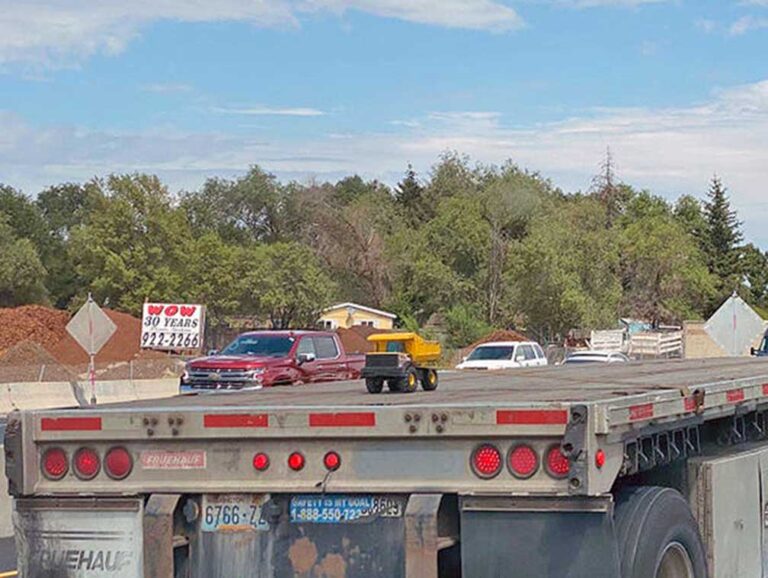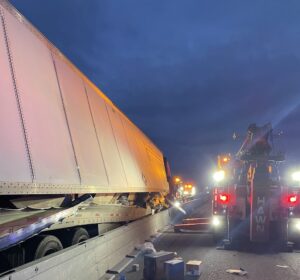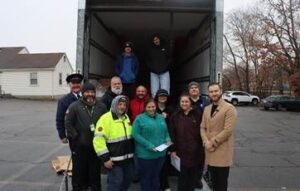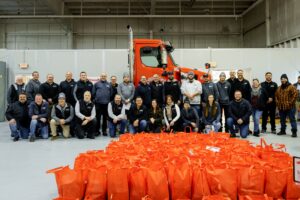NEW YORK — Container ships are stacked up by the dozen in the Pacific Ocean off the coast of California. They’re also waiting in line on New York’s coast.
As the supply chain has slowed due to a myriad of reasons, including labor shortages, many retailers are scrambling to figure out how they will get the items they need to make this Christmas season bright for shoppers — and for their bottom lines.
Some are saying that a shortage of truck drivers is to blame. But the Owner-Operator Independent Drivers (OOIDA) Association says that isn’t necessarily true.
“Pay them,” OOIDA Vice President Lewie Pugh said of drivers. “As a matter of fact, trucking companies could solve both of their top two concerns by addressing what matters most to drivers.”
Truckers who responded to a recent OOIDA survey on the issue said that compensation is the most critical issue in the industry, while “carriers insisted on perpetuating their decades-old claim that they can’t find enough workers,” according to OOIDA.
“The real problem is carriers aren’t taking the necessary steps to keep their drivers,” Pugh said. “This fact is demonstrated in other ongoing research and the high ranking of retention in this latest survey.”
Pugh said OOIDA has long held that the myth of a truck driver shortage is actually more of an extremely high turnover problem in the truckload sector.
“There is a pretty simple solution to everything and that is to pay drivers for their time,” he added. “We think it’s rather hypocritical for big trucking to keep saying there is a shortage when, according to the survey, the top concern of drivers isn’t even on their radar.”
On the flip side, the American Trucking Associations says that the truck driver shortage is the worst it’s ever been. Regardless, tons of goods remain backed up and out of consumers’ reach.
With three months until Christmas, the Basic Fun toy company has made an unprecedented decision: leave one-third of its iconic Tonka Mighty Dump Trucks destined for U.S. store shelves in China.
Why? Given surging prices of shipping containers and clogs in the supply network, transportation costs to get the yellow bulky toy to U.S. soil is now 40% of the retail price, which is roughly $26. That’s dramatically up from 7% a year ago. And it doesn’t even include the cost of getting the product from U.S. ports to retailers.
“We’ve never left product behind in this way,” says Jay Foreman, CEO of Basic Fun. “We really had no choice.”
Tonka trucks are popular among some truckers who haul them on the back of their otherwise empty flatbeds. Folklore says that if the trucks are pointing toward the cab, the driver is heading home. If the trucks are pointing away from the cab, the driver is off to catch a load.
Others say that it’s bad luck to haul an empty trailer, so that’s why the Tonka’s are strapped in.
Toy companies are racing to get their products to retailers as they grapple with a severe supply network crunch that could mean sparse shelves for the crucial holidays. They’re trying to find containers to ship their goods while searching for alternative ports. Some are flying in some of the toys instead of shipping by boat to ensure delivery before Dec. 25. And in cases like Basic Fun, they are leaving certain toys behind in China and waiting for costs to come down.
Like all manufacturers, toy companies have been facing supply chain woes since the pandemic started and temporarily closed factories in China in early 2020. Then, U.S. stores temporarily cut back or halted production amid lockdowns. The situation has only worsened since the spring, with companies having a hard time meeting surging demand for all sorts of goods from shoppers re-entering the world.
Manufacturers are wrestling with bottlenecks at factories and key ports like Long Beach California — and all points in between. Furthermore, labor shortages in the U.S. have made it difficult to get stuff unloaded from ships and onto trucks.
But for toy makers that heavily rely on holiday sales, there’s a lot at stake for the nearly $33 billion U.S. industry. The fourth quarter accounts for 70% of its annual sales. On average, holiday sales account for 20% of the overall retail industry. And 85% of the toys are made in China, estimates Steve Pasierb, CEO of The Toy Association.
The snarls are so severe that some retailers are telling companies they don’t want products if they’re shipped after mid-October. That’s because products that typically took four to six weeks from when they left a factory in China to landing at a U.S. distribution center now take 12 to 16 weeks, says Marc Rosenberg, a toy consultant.
The struggles are happening as the U.S. toy industry enjoyed a nearly 17% increase in sales last year and a 40% increase in the first half of this year as parents looked to entertain their kids at home, according to NPD Group, a market research firm.
But while analysts expect strong growth in 2021, many toy companies said they’ll see their sales reduced because they won’t be able to fulfill orders on hot items, particularly surprise hits. They are also incurring big costs that will force some toy companies to shutter.
Toy executives say they can’t raise prices any more than 10% — even though it won’t completely cover the higher costs — because they’re worried about shopper reaction. Mattel Inc., the nation’s largest toy company, warned this summer it’s raising prices in time for the holiday season to offset higher shipping costs, though it didn’t say by how much.
Costs of containers on ships have increased more than six-fold from last year with some brand executives saying they’ve gone up to $20,000 from roughly $3,000 a year ago. That has forced big retailers like Walmart and Target among others to charter their own ships.
Foreman calculates 1,800 Tonka trucks fit on each 40-foot container. So at $20,000 per container, that’s costing him $11 each. That’s up from an average of $1.75 each in a typical year. He says he’s focusing on shipping smaller items like Mash’ems — soft, squishy, water-filled collectibles — onto containers as he looks to maximize the total dollar value of the container and profit margins. He estimates he can fit $150,000 worth of Mash-ems in a container versus $40,000 worth of Tonka trucks.
Some like MGA Entertainment, the maker of L.O.L dolls, are expediting the flying of its toys because it now costs roughly the same shipping.
Jim Silver, editor-in-chief of TTPM, a toy review site, says big discounters like Target and Walmart should have a healthier supply of toys compared with smaller ones because of their clout. Target says it has been teaming up closely with its vendors and transportation partners to keep stores well-stocked and ready for its customers.
But Melissa McCollum, owner of Learning Express Toys in Birmingham, Alabama, says she’s received only 25% of the holiday toys as of mid-September; typically, that figure is 50%. And The Toy Book, the leading trade magazine serving the toy industry, is promoting a curated list of in-stock products that retailers can get fast from U.S. warehouses.
Many toy companies like Basic Fun and PlayMonster have reduced advertising.
“We would be advertising to empty shelves,” said Tim Kilpin, president of PlayMonster, who says 15% to 20% of its holiday goods are snarled in the supply chain. Koosh, a toy ball made of rubber filaments, was completely sold out in August, and there’s no chance of it being replenished by Christmas, he says.
The bottlenecks are expected to have lingering consequences. Toy makers are facing pressure from retailers to ship the first flow of holiday 2022 goods in early March instead of late April and the second cycle in June instead of by late July, says Andrew Yanofsky, head of marketing and operations at WowWee.
That will force companies to make decisions about how much to make and reorder without having a full picture of the sales data, he says.
Yanofsky said he placed a big bet initially on Got2Glow Fairy Finder, a light show in a jar that allows children to find virtual fairies, because he knew he wouldn’t be able to replenish the production given the snarls.
“We took a risk on excess material beyond the scope of what we thought we could sell, ” he said.
Even the few toy companies that make goods in the U.S. have struggled because of labor shortages.
John Gessert is CEO and president of American Plastic Toys, based in Walled Lake, Michigan with another plant in Mississippi. He says the company is missing 35% to 40% of its front-line workers. Now, it’s shifting away its focus on play kitchens that require six workers and more toward less labor intensive toys like basketball sets, which require just three workers to put together.
“I have never had such a complicated puzzle to fix. “he said.
The Associated Press contributed to this report.
The Trucker News Staff produces engaging content for not only TheTrucker.com, but also The Trucker Newspaper, which has been serving the trucking industry for more than 30 years. With a focus on drivers, the Trucker News Staff aims to provide relevant, objective content pertaining to the trucking segment of the transportation industry. The Trucker News Staff is based in Little Rock, Arkansas.
















I think the United states should bring back our industry and start making stuff here in the United states and not import as much as we do now.I knew when I was in 8th grade importing would be a bad thing the United states could do because it caused us to loose all our industries and factories. We should make things here and have items to export instead.
Buy used items at thrift stores.
Temporary Lift the restrictions and pay us our worth organize them Cali and New York ports and watch how fast them ships get unloaded va and nc ports are not having this problem in fact we need chassis we got the drivers and the loads we just lose time waiting in 40/45 foot chassis